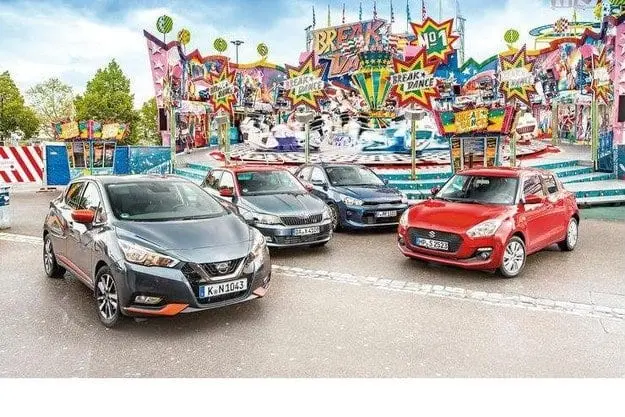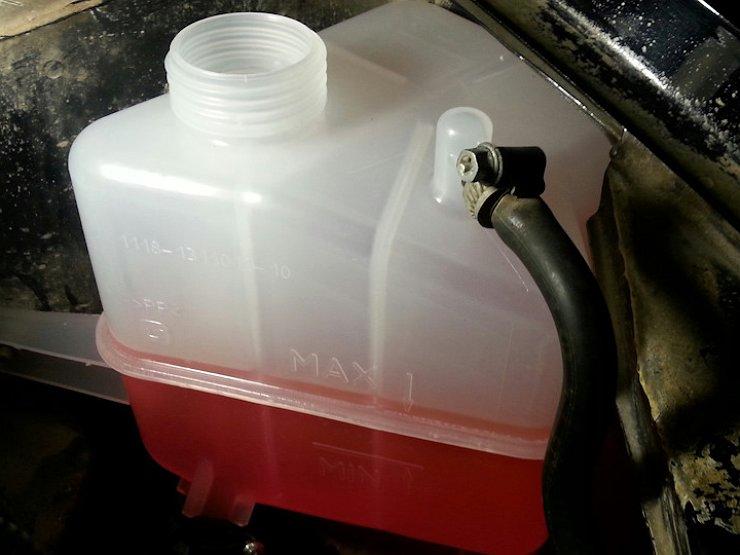
Test drive Kia Rio, Nissan Micra, Skoda Fabia, Suzuki Swift: Children
Content

Will the new Korean model be able to compete for a worthy place in the subcompact class?
Affordable prices, good equipment and a long warranty period are well-known advantages of Kia. However, more is expected from the new Rio: it should be equal to the best in its class. In the first comparative test, the model competes with Micra, Fabia and Swift.
First there was Pride, then Rio - the history of Kia's small lineups is not much longer than the history of the Euro. The most outstanding quality of the first Rio in 2000 was that it was the cheapest new car on the US market. And now, after three generations, the model is ready to compete with competitors from Europe and Japan. Let's see if this works. In this comparison test, the little Kia will compete with also quite fresh ones. Nissan Micra and Suzuki Swift, as well as the very famous Skoda Fabia.
Gasoline engines from 90 to 100 hp have become almost standard in this category - most recently as three-cylinder downsized turbocharged cars, as in Kia and Nissan, but also as four-cylinder forced (Skoda) or naturally aspirated (Suzuki) filling. However, in the case of Fabia, it should be noted that here the model is involved with a 1.2 TSI engine. Already this year, this power unit will be replaced by a one-liter three-cylinder engine with 95 hp. (from 17 euros in Germany). Since the new engine was not yet available at the time of the test, the right to participate was again given to its four-cylinder counterpart.
Economical Suzuki Swift
This should by no means be a disadvantage, as Swift proves. In this test, it is powered by a four-cylinder even naturally aspirated, making it exotic in downsizing days. Naturally, the 90 hp Suzuki engine. his seemingly outdated technique did not go unnoticed. For example, it drives a crankshaft with a rather tired 120 Nm of torque at only 4400 rpm and subjectively feels a little overloaded and noisy. But what really matters is the objective result.
In the Swift with a four-cylinder Dualjet engine, this result translates into acceptable dynamic performance, and also - attention! – the lowest fuel consumption in the test. True, the differences are not very large, but 0,4-0,5 liters in everyday driving can be an argument in this class of cars. With an annual mileage of 10 km, today's fuel prices in Germany save about 000 euros. Or, in other words, 70 kilograms of CO117, which is also important for some.
However, this almost completely describes the description of Suzuki's talents. Despite a completely new design on a different platform, Swift has some outstanding features. It is very light, but hardly noticeable in handling. The car is reluctant to change direction, and the oddly insensitive steering system further reduces driving pleasure. In terms of area, Swift is not among the top performers in its environment, although there are improvements.
The equipment and price remained the same because (in Germany) the Suzuki model is the cheapest car in this test. With the base engine, it starts at €13 and up, while the Comfort variant shown here is listed at €790. Metallic lacquer is available as an option, radio and air conditioning are standard. Navigation and Lane Keeping Assist is only available on the expensive Comfort Plus trim level, which can only be ordered with the turbocharged three-cylinder engine. Compared to competitors, this range is quite modest.
Extroverted Micra
Competitors under consideration include the Nissan Micra, which has produced seven million units since 1982. The first also bore the name Datsun. This year comes the fifth generation of the model, which at first glance impresses with a rather extroverted design. First of all, the steeply rising rear window line, as well as the sloping roofline and sculpted taillights, show that form doesn't always follow function here.
In fact, design criticisms can't be part of a comparison test, but the Micra suffers from real functional deficiencies, such as poor visibility, as well as limited space in the rear seats and in the trunk. Otherwise, the interior impresses with decent quality, good furniture and a friendly atmosphere. Especially when, like our test car, it has particularly rich N-Connecta equipment - then 16-inch alloy wheels, a navigation system, keyless start, and a leather steering wheel rain sensor are all part of the factory package - so the basic the price of 18 euros seems quite calculated.
Drive is provided by a 0,9-liter three-cylinder engine, which leaves a mixed impression in this test. It seems relatively weak, runs unevenly and noisily, and consumes the most fuel, although the differences to the Fabia and Rio engines are minimal. It's also tricky with the chassis - it's rigidly tuned, not giving the Micra much flair for handling, hampered by vaguely responsive steering. Thus, the Nissan model cannot create a truly positive profile.
Solid Skoda
Somehow we got used to the fact that in comparative tests in the B-segment Fabia is at the top of the honorary ladder. This is not the case this time - and not because the test car runs much worse or uses an engine that, as we mentioned, will be replaced during the model year.
But let's continue the line: a 90 hp four-cylinder engine. comes from the EA 211 modular engine family, as well as the 95 hp three-cylinder engine that will soon replace it. In this test, he impresses with good manners, a smooth gait and restraint in terms of noise. But he is not a sprinter, so Fabia is among the more tired participants, only the Nissan model is more clumsy than her. And at a cost of 1.2 TSI, it shows average results - this is approximately on par with competitors.
On the other hand, Fabia continues to be a leader in terms of driving comfort and interior space. In addition, its functions are the easiest and most intuitive to operate, and the level of quality is the highest. The model tolerates minor flaws in the safety equipment, where it loses a few points compared to the Rio and Micra. For example, they are equipped with camera-based lane keeping and emergency stop assistants. Here you can see that several years have passed since the presentation of the Fabia in 2014. In Germany, it's not particularly cheap. Although the Rio and Micra are more expensive, they offer significantly richer equipment for the price. Until now, the lead in other sections has always been sufficient, but now it is not - Skoda finishes a few points less than Kia.
Harmonious Kia
The reason is not the sheer superiority of the new Rio. It makes a much stronger impression thanks to the harmonious package and, above all, the determination with which Kia designers have grappled with the shortcomings of previous models. Easy operation of functions and a stylish, well-executed interior were some of the strengths of the previous generation. However, the same could not be said for the steering system, which until recently showed rather indistinctness and timid feedback.
However, in the new Rio, he makes a good impression with immediate response and decent contact information. The same goes for suspension comfort. Not being completely at the Skoda level - first of all, there is still room for improvement in the response to bumps - and here the distance to the best in this class has almost completely disappeared. And since the Rio now has fairly comfortable, albeit somewhat weak, side-supported seats, it's close to the Fabia in terms of comfort.
In this test, the Kia model appeared with a new three-cylinder turbo engine with 100 hp. and paired with a five-speed manual transmission. The new engine does its job well, offering the best dynamic performance and the most confident driving experience. In terms of cost, it is at the level of competitors, which may be due to the fact that the Rio is a bit overweight - almost four meters in length and almost 50 kg heavier than the Fabia. However, he defeats rivals - this Kia today could rightly be called Pride again.
Text: Heinrich Lingner
Photo: Dino Eisele
Evaluation
1. Kia Rio 1.0 T-GDI – 406 points
The Rio wins simply because it is the most harmonious car in the tests, with excellent equipment and a long warranty.
2. Skoda Fabia 1.2 TSI - 397 points
The best quality, space and refined comfort are not enough - the Skoda model is no longer quite young.
3. Nissan Micra 0.9 IG-T – 382 points
For a brand new car, the model was a bit disappointing. Security and communication equipment in good condition.
4. Suzuki Swift 1.2 Dualjet – 365 points
Swift is an extremist - small, light and economical. But there are not enough qualities to win the test.
technical details
| 1. Rio 1.0 T-GDI | 2. Skoda Fabia 1.2TSI | 3. Nissan Micra 0.9 IG-T | 4. Suzuki Swift 1.2 Dualjet | |
|---|---|---|---|---|
| Working volume | 998 cc | 1197 cc | 898 cc | 1242 cc |
| Power | 100 k.s. (74 kW) at 4500 rpm | 90 k.s. (66 kW) at 4400 rpm | 90 k.s. (66 kW) at 5500 rpm | 90 k.s. (66 kW) at 6000 rpm |
| Maximum torque | 172 Nm at 1500 rpm | 160 Nm at 1400 rpm | 150 Nm at 2250 rpm | 120 Nm at 4400 rpm |
| Acceleration 0-100 km / h | 10,4 with | 11,6 with | 12,3 with | 10,5 with |
| Braking distances at a speed of 100 km / h | 37,0 m | 36,1 m | 35,4 m | 36,8 m |
| full speed | 186 km / h | 182 km / h | 175 km / h | 180 km / h |
| Average consumption fuel in the test | 6,5 l / 100 km | 6,5 l / 100 km | 6,6 l / 100 km | 6,1 l / 100 km |
| Base Price | 18 590 EUR (in Germany) | 17 280 EUR (in Germany) | 18 590 EUR (in Germany) | 15 740 EUR (in Germany) |
